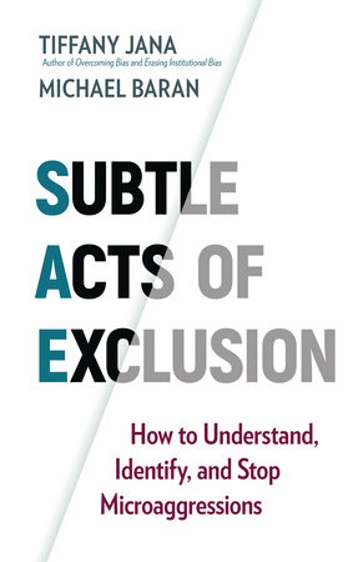Perhaps we should say the road to harm is paved with good intentions. It certainly comports with much of the contents of Michael Baran and Tiffany Jana’s book Subtle Acts of Exclusion: How to Understand, Identify, and Stop Microaggressions. This incisive and well researched look at the problem of microaggression/exclusionary behavior in modern society never casts aspersions on individuals, per se, but instead calls on us to recognize each of us have often used intemperate language capable of diminishing the stature and humanity of those around us. Jana is an academic and CEO of TMI Portfolio, a conglomerate of individual brands working to address such issues in both the workplace and everyday life, Baran is a Senior Partner and Digital Solutions Lead at inQUEST Consulting, working to support organizations in their diversity, equity, and inclusion efforts. By training, he is a social scientist who has taught at Harvard University and conducted applied research for the American Institutes for Research. .
I enjoy the fact the book isn’t a weighty academic tome bogging readers down with dry language and an abundance of charts and graphs supporting their positions. There is a plethora of research they utilize to support their ideas, but they present the bulk of their ideas framed in very human terms, through the prism of individual experience, rather than raw data alone. They start things off by setting the groundwork for the book’s subject matter and discussing a bit of its linguistic history, the societal dialogue accompanying reception of those ideas, and their response to such dialogue.
I also admire how, despite the academic slant of their assorted definitions, they are wholly understandable. They clearly aim to create a reading experience where anyone can take the necessary information away from the text without having to wade their way through a morass of dense scholarly webs. They, likewise, show careful consideration for providing their readers a clear path for reducing these behaviors and vocalizing their recognition of such behavior. I believe many readers will be impressed, as I am, by their through overview of the subject – they touch on the many different areas where subtle acts of exclusion manifest themselves and delve into each with unflinching intelligence.
AMAZON: https://www.amazon.com/Subtle-Acts-Exclusion-Understand-Microaggressions-ebook/dp/B07Y3TYRB6
The wealth of experiences they build into the book makes it an indispensible read. They focus, for the most part, on the experiences of others, but including their own is a key component of the book’s power. Moreover, both Jana and Baran concede they are no better than the rest of us – they have participated in subtle acts of exclusion and this relative rare move from an author, or in this case authors, to join the reader in the subject matter is more than laudable. The Notes section is complete and documents the aforementioned research for those looking to do more reading on their own. The one quibble some may have with the book is there is a certain amount of repetition throughout the text; we’re often subjected to the same terms they establish early on, but I think it is the authors simply looking to reinforce key points. Nevertheless, Subtle Acts of Exclusion: How to Understand, Identify, and Stop Microaggressions is an essential text on this subject and has lasting value.
Garth Thomas

